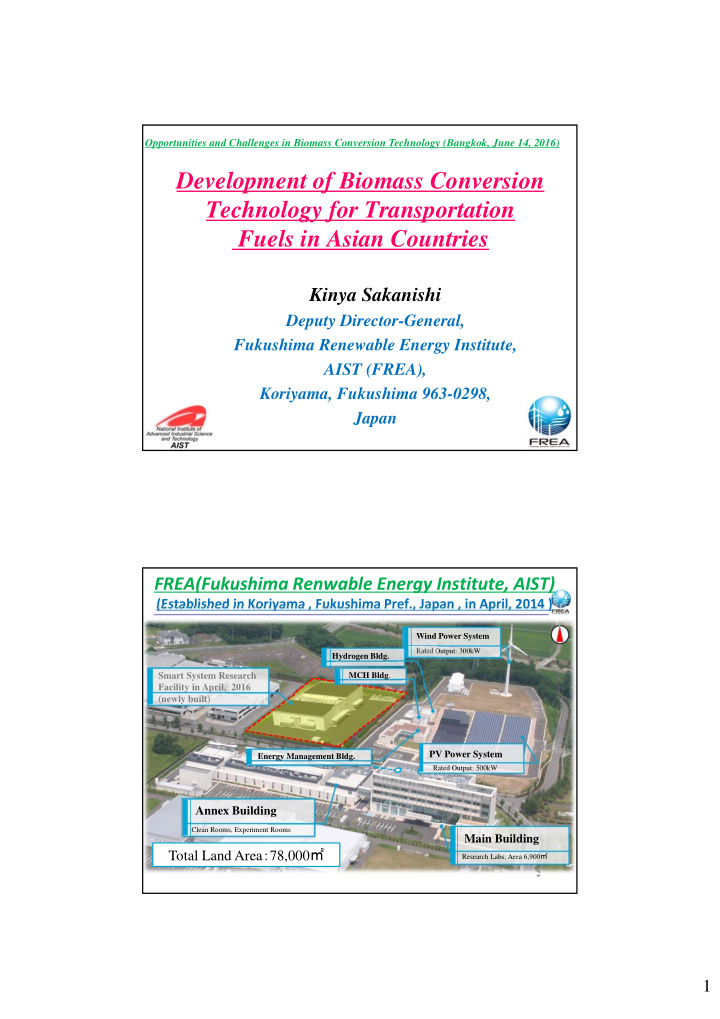



Opportunities and Challenges in Biomass Conversion Technology (Bangkok, June 14, 2016) Development of Biomass Conversion Technology for Transportation Fuels in Asian Countries Kinya Sakanishi Deputy Director-General, Fukushima Renewable Energy Institute, AIST (FREA), Koriyama, Fukushima 963-0298, Japan FREA(Fukushima Renwable Energy Institute, AIST) (Established in Koriyama , Fukushima Pref., Japan , in April, 2014 ) Wind Power System Rated Output: 300kW Hydrogen Bldg. Smart System Research MCH Bldg . Facility in April, 2016 (newly built) PV Power System Energy Management Bldg. Rated Output: 500kW Annex Building Clean Rooms, Experiment Rooms Main Building Total Land Area : 78,000 ㎡ Research Labs, Area 6,900 ㎡ 2 1
Renewable Energy Network at FREA System R&D for renewable energies mass introduction • MW PV, wind power integration with storage (batteries, hydrogen) • ICT network for power generation forecast and system control • Test bed for new technology (power electronics etc.), demonstration • International standardization 3 Hydrogen Carrier Production / Application • Hydrogen production from PV, wind turbine output • Conversion to organic-hydrate (liquid at room temperature), large scale storage at high density for long term 3H 2 + C 6 H 5 CH 3 C 6 H 11 CH 3 ( methyl-cyclohexane ) • – Hydrogenation / dehydrogenation by catalytic reaction • Combined heat and power application by engine / fuel cell 4 2
Ministry of Economy, Major Developments of Biomass Policy in Japan Trade and Industry Agency of Natural Resourcesand Energy ■ After the Great East Japan Earthquake and subsequent nuclear accident happened, the biomass industrialization strategy was drawn as principle to create regional green industry and fortify an independent and distributed energy supply system. Year Policies 2002 Biomass Nippon Strategy 2005 Kyoto Protocol – Target Achievement Plan 2009 Basic Act for the Promotion of Biomass Utilization Basic Energy Plan ( Revised) 2010 2010 National Plan for the Promotion of Biomass Utilization 2011.3.11 Great East Japan Earthquake and Accident of Fukushima 1 st Nuclear Power Plant 2012 Biomass Industrialization Strategy Basic Energy Plan (Revised ) 2014 Source: Ministry of Agriculture,Forestry and Fisheries 6 3
Biomass Supply Prospects – Uncertainties Remain Source: Adapted from IPCC (2011), and supplemented with IEA data < Source: Based on IPCC SRREN, 2011 > • Total biomass demand for heat, power and biofuels reaches 8-11 billion tons in 2050 • Intermediate targets should be adopted to enhance international biomass trade, and assess costs and impact on sustainability 8 4
Scheme of Sustainable Asian Biomass Strategy => Asian-Pacific & Worldwide Collaborations Best Practice Scenario and System for Sustainable Biomass Utilization Models in East Asian Countries Win-Win China relationship Total Promotion of Biomass Asia Strategy Extensive Win-Win Collaboration in Asia International R&D Joint Projects on Biomass, Especially agriculture and engineering fields Japan Technology, IP, Human resources ASEAN Resources, Economical development, Technology transfer Energy, Materials, CO 2 reduction : CDM&JCM ⇒ Sustainable Development Foresight of ASEAN Agricultural Residue in 2030 (Converted into Ethanol x1000 kL) * The figures in yellow background are the promising quantities for producing ethanol Source : NEDO Research Report in 2007 10 5
Target Technology & Products for Biomass Utilization Biomass Target Technology Products Two-stage Sewage Sludge Methane & Hydrothermal Fermentation, & Hydrogen Pretreatment, & Waste-water Carbonization treatment Food Wastes Fertilizer, Animal feed BTL with catalysis, MeOH, Agricultural Waste Flash pyrolysis & DME, (rice husk & straw, Gasification for CHP Synthetic baggasse etc. Fuels, Olefins Extraction & Hydrogen Energy Crops Catalysis etc. (Cassava, Sugar Cane, Oil palm, BDF Jatropha, Sago Plant Growth, Bioplastics, Fermentation Palm etc.) Clone Identification Bio-chemicals Aquatic Biomass Non-acidic Pretreatments Bioethanol, Forestry Products, (Hot-compressed Water&Mechano-chemical Bio-ethylene, milling) Old palm trunk etc. Bio-propylene Technical and Post Doctoral Training Standardization in Asia & Biomass LCA (NREL etc.) (JICA/JST, NEF, AIST fellowship etc.) JIS, and ISO Overall Biomass Refinery Scheme 6
13 7
8
9
Principles of Biomass Refining Technology To overcome “Biomass Recalcitrance”: responsible for the high cost of lignocellulose conversion. Cell wall structure: Natural nanocomposite Nanospace formation between cellulose microfibrills by HCW treatment Nanofibrillation by the combined method of HCW treatment and wet- milling process Morphology of the fibrillated products by wet-milling after the hot compressed water (HCW ) treatment. De-lignification of wet-milled Enzymatic product Saccharification and Lignin Recovery 10
11
Thank you ! For further information: frea-info-ml@aist.go.jp Tel: +81 (0)24-963-1805 24 12
Recommend
More recommend